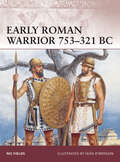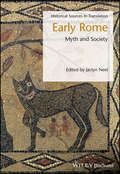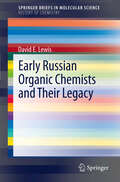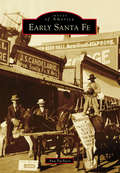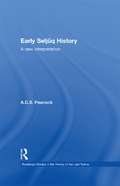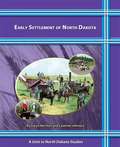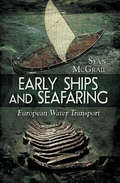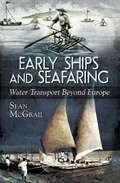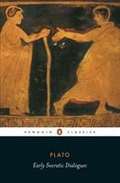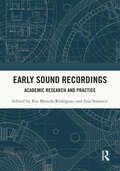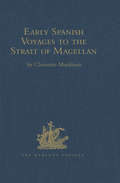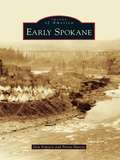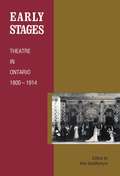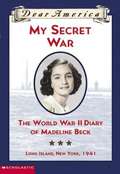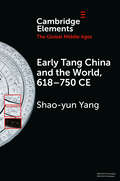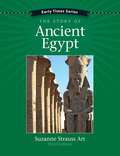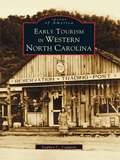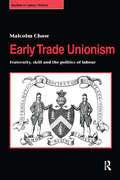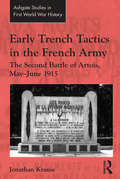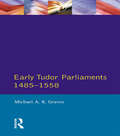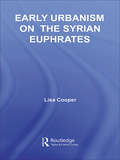- Table View
- List View
Early Roman Warrior 753-321 BC
by Nic Fields Sean O'BrogainThe prototypical 'Roman Legionnaire' often seen on television and in movies is actually the product of nearly a millennium of military development. Far back in the Bronze Age, before the city of Rome existed, a loose collection of independent hamlets eventually formed into a village. From this base, the earliest Roman warriors launched cattle raids and ambushes against their enemies. At some point during this time, the Romans began a period of expansion, conquering land and absorbing peoples. Soon, they had adopted classical Greek fighting methods with militia forming in phalanxes. This book covers the evolution of the earliest Roman warriors and their development into an army that would eventually conquer the known world.From the Trade Paperback edition.
Early Rome: Myth and Society (Blackwell Sourcebooks in Ancient History)
by Jaclyn NeelThe scholarly community has become increasingly aware of the differences between Roman myths and the more familiar myths of Greece. Early Rome: Myth and Society steps in to provide much-needed modern and accessible translations and commentaries on Italian legends. This work examines the tales of Roman pre-and legendary history, discusses relevant cultural and contextual information, and presents author biographies. This book offers updated translations of key texts, including authors who are often absent from classical mythology textbooks, such as Dionysius of Halicarnassus and Servius. Editor Jaclyn Neel debunks the idea that Romans were unimaginative copyists by spotlighting the vitality and flexibility of Italian myth — particularly those parts that are less closely connected to Greek tales, such as the story of Caeculus of Praeneste. Finally, by calling attention to the Italian rather than Roman nature of the collection, this book suggests that Roman culture was broader than the city itself. This important work offers: Up-to-date and accessible translations of Roman and Italic legends from authors throughout antiquity Examination of compelling tales that involve the Roman equivalent of Greek “heroes” Unique view of the strength and plasticity of Roman and Italic myth, particularly the parts less closely connected to familiar Greek tales Intelligent discussion of relevant cultural and contextual information Argument that Roman culture reached far beyond the city of Rome Fresh and readable, Early Rome: Myth and Society offers essential reading for students of ancient Rome as well as those interested in Roman and Greek mythology.
Early Royko: Up Against It in Chicago
by Mike Royko Rick KoganEarly Royko restores to print the earliest writings of the legendary columnist Jimmy Breslin called the best journalist of his time. Here, Royko chronicles 1960s Chicago with the moral vision, irony, and razor-sharp voice that would remain his trademark.
Early Russian Organic Chemists and Their Legacy
by David E LewisThe organic chemists of Russia during the pre-revolutionary period included some of the most creative and talented chemists of the nineteenth and early twentieth centuries. Indeed, this is attested by the number of reactions and empirical rules bearing their names. This volume is of interest for both historians of chemistry and organic chemists wishing to discover more about the historical development of their discipline in Russia. From the founding of the Russian Academy of Sciences by Peter the Great in 1725 to the early years of the nineteenth century, Russian organic chemistry was largely in the hands of foreign scientists. However, the Russification of organic chemistry in Russia had begun before the middle of the nineteenth century, and reached its zenith during the last half of the same century, by which time vibrant schools of chemistry had arisen in the eastern city of Kazan', at Moscow and at St. Petersburg. By the end of the century, the Chairs of organic chemistry at universities throughout the Russian empire were occupied by Russian chemists, almost half of them trained at Kazan'. This volume discusses the contributions of these organic chemists which include: the structural theory of organic chemistry, empirical rules for addition and elimination, reactions involving carbon nucleophiles, such as the aldol reaction and alcohol synthesis using organozinc nucleophiles, the discovery of sulfoxides and sulfonium salts, and a range of important redox reactions.
Early Samurai AD 200-1500
by Angus Mcbride Anthony BryantWar played a central part in the history of Japan. Warring clans controlled much of the country. The wars were usually about land, the struggle for control of which eventually gave rise to perhaps the most formidable warriors of all time: the Samurai. Ancient Yayoi warriors developed weapons, armour and a code during the ensuing centuries that became the centrepiece for the Japanese Samurai. Anthony Bryant chronicles the history, arms and armour of these truly élite warriors, from the rise of the Yayoi through the Genpei War (1180-1185) between the Minamoto and Taira clans, to the Mongol invasions of the 13th century.
Early San Juan County
by Laverne Tate San Juan County Historical SocietySan Juan County was established in 1880 following the famous winter trek and steep descent through the Hole-in-the-Rock Trail to Bluff, Utah. Behind the settlement of this community by the San Juan River is a story of tenacity, determination, and hardship. The Hole-in-the-Rock was a sandstone crevice discovered fortuitously by pioneers when a wild ram escaped its pursuers and descended to the river by that route. After blasting, building up the grade, and lowering by ropes, the wagon train finally emerged through the crevice to the river below and finished the last difficult miles into Bluff. Miner and photographer Charles Goodman documented the early days of San Juan County, from the production of bricks and molasses to the establishment of Bluff Oil Company, and many of his unique images, dating from 1892 to 1913, are included in this volume.
Early Santa Fe (Images of America)
by Ana PachecoThe history of Santa Fe is encapsulated in imagery. Remnants of unearthed Native American artifacts from eons ago shed light on its first inhabitants. By the 17th century, Spanish settlers were capturing everyday life with brushstrokes on canvas. In the 1850s, the epic of this ancient land was brought to life through the camera’s lens. These early images, which tell the story of the convergence of humanity, are as varied as the people themselves. They arrived at different times on the four major arteries that connect in the heart of the city: the Camino Real (from Mexico City), the Santa Fe Trail (from Independence, Missouri), the Old Spanish Trail (from Los Angeles), and the Mother Road, Route 66, which began in Chicago.
Early Seljuq History: A New Interpretation (Routledge Studies in the History of Iran and Turkey)
by A.C.S. PeacockThis book investigates the early history of the Seljuq Turks, founders of one of the most important empires of the mediaeval Islamic world, from their origins in the Eurasian steppe to their conquest of Iran, Iraq and Anatolia. The first work available in a western language on this important episode in Turkish and Islamic history, this book offers a new understanding of the emergence of this major nomadic empire Focusing on perhaps the most important and least understood phase, the transformation of the Seljuqs from tribesmen in Central Asia to rulers of a great Muslim Empire, the author examines previously neglected sources to demonstrate the central role of tribalism in the evolution of their state. The book also seeks to understand the impact of the invasions on the settled peoples of the Middle East and the beginnings of Turkish settlement in the region, which was to transform it demographically forever. Arguing that the nomadic, steppe origins of the Seljuqs were of much greater importance in determining the early development of the empire than is usually believed, this book sheds new light on the arrival of the Turks in the Islamic world. A significant contribution to our understanding of the history of the Middle East, this book will be of interest to scholars of Byzantium as well as Islamic history, as well as Islamic studies and anthropology.
Early Settlement of North Dakota (North Dakota Studies)
by Gwyn S. Herman Laverne A. JohnsonThe settlement of North Dakota by Euro-Americans is significantly tied to transportation. The first "highways" were the rivers which brought most of the early explorers and fur traders and the first "white" settlers to North Dakota by boat. Later on, Red River carts, stagecoaches, and trains served people and businesses on the North Dakota frontier and during the time of early settlement.
Early Ships and Seafaring: European Water Transport
by Seán McGrailEarly Ships and Seafaring: Water Transport Within Europe' builds on Professor Sen McGrail's 2006 volume 'Ancient Boats and Ships' by delving deeper into the construction and use of boats and ships between the stone age and AD1500 in order to provide up to date information. Regions covered will include the Mediterranean and Atlantic Europe.This interesting volume is easily accessible to those with little t no knowledge of the building and ises of boats, whether ancient or modern. Sen McGrail introduces the reader to this relatively new discipline through the theory and techniques used in the study of early boats as well as the many different types of evidence available to us, including archaeological, documentary, iconographic, experimental and ethnographic, and the natural, physical laws.
Early Ships and Seafaring: Water Transport Beyond Europe
by Seán McGrailIn this volume Professor Sen McGrail introduces the reader to a relatively new branch of Archaeology the study of water transport how early rafts, boats and ships were built and used. Concepts, such as boatbuilding traditions, ship stability and navigation without instruments, are first described. Archaeological research is then discussed, including sea levels in earlier times, how to distinguish the vestigial remains of a cargo vessel from those of a fighting craft; and the difference between a boat and a ship.Chapters 2 and 3, the heart of the text, deal with the early water transport of the Mediterranean and Atlantic Europe, from the Stone Age to Medieval times. Each chapter includes a description of the region's maritime geography and an exposition of its boat-building traditions. The third element is a discussion of the propulsion, the steering and the navigation of these early vessels.The sparse, often jumbled, remains of excavated vessels have to be interpreted, a process that is assisted by consideration of early descriptions and illustrations. Studies of the way traditional builders of wooden boats ply their trade today are also a great help. Experimental boat archaeology is still at an early stage but, when undertaken rigorously, it can reveal aspects of the vessel's capabilities. Such information is used in this volume to further our understanding of data from boat and ship excavations, and to present as coherent, comprehensive and accurate a picture as is now possible, of early European boatbuilding and use.
Early Skiing on Snoqualmie Pass (Sports)
by John W. Lundin Dave MoffettRelive the exciting early days of skiing when Snoqualmie Pass was the epicenter of the sport. Ski jumping tournaments attracted world-class competitors to Cle Elum, Beaver Lake on the Summit and the Milwaukee Ski Bowl. The Mountaineers� twenty-mile race from Snoqualmie to Stampede Pass, dubbed �the world�s longest and hardest race,� was a pinnacle of cross-country skiing. Alpine skiing began in private ski clubs and expanded in 1934 with the country�s first municipal ski area, known as the Seattle Municipal Ski Park. And the sport peaked when the Milwaukee Ski Bowl at Hyak opened in 1938. With train access, a modern ski lodge, an overhead cable lift and free ski lessons from the Seattle Times, the Ski Bowl revolutionized local skiing. Lawyer and local ski historian John W. Lundin follows the historic tracks through the genesis of American skiing.
Early Socratic Dialogues
by Plato Chris Emlyn-Jones Trevor J. SaundersRich in drama and humour, they include the controversial Ion, a debate on poetic inspiration; Laches, in which Socrates seeks to define bravery; and Euthydemus, which considers the relationship between philosophy and politics. Together, these dialogues provide a definitive portrait of the real Socrates and raise issues still keenly debated by philosophers, forming an incisive overview of Plato’s philosophy.
Early Sound Recordings: Academic Research and Practice
by Eva Moreda Rodríguez Inja StanovićThe use of historical recordings as primary sources is relatively well established in both musicology and performance studies and has demonstrated how early recording technologies transformed the ways in which musicians and audiences engaged with music. This edited volume offers a timely snapshot of a wide range of contemporary research in the area of performance practice and performance histories, inviting readers to consider the wide range of research methods that are used in this ever-expanding area of scholarship. The volume brings together a diverse team of researchers who all use early recordings as their primary source to research performance in its broadest sense in a wide range of repertoires within and on the margins of the classical canon – from the analysis of specific performing practices and parameters in certain repertoires, to broader contextual issues that call attention to the relationship between recorded performance and topics such as analysis, notation and composition. Including a range of accessible music examples, which allow readers to experience the music under discussion, this book is designed to engage with academic and non-academic readers alike, being an ideal research aid for students, scholars and performers, as well as an interesting read for early sound recording enthusiasts.
Early Spanish Voyages to the Strait of Magellan: Translated And Edited With A Preface, Introduction And Notes (classic Reprint) (Hakluyt Society, Second Series #Vol. 28)
by Clements MarkhamNarratives, translated and edited, with a preface, introduction and notes, of the second voyage through the strait, commanded by the Comendador Loaysa and Sebastián del Cano, 1524-6, the third voyage, under the command of Simón de Alcazaba, 1534-5, and the reconnaissance by Bartolomé and Gonzalo de Nodal, 1618-19; with a fragment relating to the expedition sent by the bishop of Plasencia under Alonso de Camargo, 1539-41. Contents: Introduction to the expedition of the comendador Loaysa and Juan Sebastian del Cano.-List of survivors of the Magellan expedition brought back by Juan Sebastian del Cano, in the Victoria.-Expedition of the comendador Loaysa to Maluco.-Narrative of the Loaysa expedition by Captain Andres de Urdaneta.-Description of the strait of Magellan by the pilot Martin de Uriarte.-Narrative of the voyage of the pinnace Santiago.-Narrative of the voyage of Alvarez de Sayavedra by Vicencio of Naples.-Introduction to the expedition of Simon de Alcazaba.-Principal officers of Alcazaba's expedition.-Narrative of the expedition of Simon de Alcazaba by Alonso (Veedor) This is a new print-on-demand hardback edition of the volume first published in 1911.
Early Spokane
by Penny Hutten Don PopejoySpokan Falls, known as the "Capital of the Inland Empire," was named after the Spokan Indians and the picturesque falls. In 1891, the name was changed to Spokane. The town thrived as a result of the abundant waters of the Spokane River, which powered saw and grain mills, and lured major transcontinental railways to Spokane in 1881. In 1889, a fire destroyed the downtown area, but like a forest after a fire, the town enjoyed growth and resurgence soon after. Spokane would attract people as diverse as Pres. Theodore Roosevelt, Calamity Jane, Billy Sunday, and Charles Lindbergh. Easterners found that its four seasons and profusion of scenic city parks gave them a place to ensure their destiny.
Early Stages: Theatre in Ontario 1800 - 1914 (The Royal Society of Canada Special Publications)
by Anne SaddlemyerA circus, a production of Shakespeare, an evening of song and ventriloquism, a performance by a ‘learned pig’ – all of these offered an evening’s entertainment to the citizens of early nineteenth-century Upper Canada. Although the population in 1800 was only 90,000, a wide range of entertainers performed in towns across the province: touring companies, variety and animal acts, and theatrical troupes, professional and amateur, some home-grown and based in the garrisons, others from Montreal, New York, and London. By the end of the century, some 250 touring groups were on the road across Ontario, from Ottawa to Rat Portage (now Kenora). The lively theatre tradition of that century would extend into the next, beyond the appointment in 1913 of Ontario’s first official censor, until the outbreak the following year of the First World War. This collection of essays covers a number of facets of the growth of theatre in Ontario. Ann Saddlemyer’s introduction provides an overview of the period, and historian J.M.S. Careless focuses on the cultural environment. Novelist Robertson Davies writes on the dramatic repertoire of the period. Architect Robert Fairfield explores the structures that housed performances, from the small community halls to the grand opera houses. Theatre scholar and professional actor and director Geralrd Lenton-Young discusses variety performances. Leslie O’Dell, scholar, actor, and playwright, writes on garrison theatre, while Mary M. Brown, a teacher, actress, and director, covers travelling troupes. A chronology and bibliography, both by the theatre scholar Richard Plant, complete the work. A second volume, scheduled for future publication, will look at the development of theatre in Ontario in the twentieth century. (Ontario Historical Studies Series)
Early Sunday Morning: The Pearl Harbor Diary of Amber Billows (Dear America)
by Barry DenenbergDiary of Amber Billows from the World War II era. Part of the Dear America series.
Early Tang China and the World, 618–750 CE (Elements in the Global Middle Ages)
by Shao-yun YangFor about half a century, the Tang dynasty has held a reputation as the most 'cosmopolitan' period in Chinese history, marked by unsurpassed openness to foreign peoples and cultures and active promotion of international trade. Heavily influenced by Western liberal ideals and contemporary China's own self-fashioning efforts, this glamorous image of the Tang calls for some critical reexamination. This Element presents a broad and revisionist analysis of early Tang China's relations with the rest of the Eurasian world and argues that idealizing the Tang as exceptionally “cosmopolitan” limits our ability to think both critically and globally about its actions and policies as an empire.
Early Times series: The Story of Ancient Egypt Third Edition
by Suzanne Strauss ArtSoaring limestone-faced pyramids and pillared temples, picture-writing and magical amulets, animal-faced deities and painted mummy cases--ancient Egypt was as colorful as it was mysterious. It was also a major political power. Meet the priests, scribes and artists who enriched the culture, the peasants who labored by the Nile to support the population, and the pharaohs who kept the nation strong.
Early Tourism in Western North Carolina
by Stephen C. ComptonAt the beginning of the 20th century, many Americans moved from farm to town, changing from agricultural employment to jobs in factories and retail shops. Along with these new occupations came a new idea called "vacation." Ready access to automobiles made leisure travel, once reserved for affluent citizens, increasingly feasible and affordable for working class people. With its cool climate and outstanding scenery, the mountain region of North Carolina became a welcome refuge and ideal tourist destination for weary workers and their families. Western North Carolina, often touted in promotional materials as the "land of the sky," hosts Mount Mitchell-the highest mountain east of the Mississippi River-hundreds of waterfalls, some of the world's oldest mountains and rivers, and abundant wildlife. The well-known Blue Ridge Parkway, numerous inns, lodges, hotels, campgrounds, and restaurants were constructed to serve the region's growing number of visitors.Early Tourism in Western North Carolina celebrates the rise of tourism from 1900 to 1950 in the Blue Ridge and Appalachian mountains of North Carolina. Sites featured include the Great Smoky Mountains National Park, the Blue Ridge Parkway, Grandfather Mountain, Blowing Rock, Asheville, Mount Mitchell, Chimney Rock, the Biltmore Estate, and the Cherokee Indian Reservation.
Early Trade Unionism: Fraternity, Skill and the Politics of Labour (Studies in Labour History)
by Malcolm ChaseOnce the heartland of British labour history, trade unionism has been marginalised in much recent scholarship. In a critical survey from the earliest times to the nineteenth century, this book argues for its reinstatement. Trade unionism is shown to be both intrinsically important and to provide a window onto the broader historical landscape; the evolution of trade union principles and practices is traced from the seventeenth century to mid-Victorian times. Underpinning this survey is an explanation of labour organisation that reaches back to the fourteenth century. Throughout, the emphasis is on trade union mentality and ideology, rather than on institutional history. There is a critical focus on the politics of gender, on the demarcation of skill and on the role of the state in labour issues. New insight is provided on the long-debated question of trade unions’ contribution to social and political unrest from the era of the French Revolution through to Chartism.
Early Trench Tactics in the French Army: The Second Battle of Artois, May-June 1915 (Routledge Studies in First World War History)
by Jonathan KrauseIn the English-speaking world the First World War is all too often portrayed primarily as a conflict between Britain and Germany. The vast majority of books focus on the Anglo-German struggle, and ignore the dominant part played by the French, who for most of the war provided the bulk of the soldiers fighting against the central powers. As such, this important and timely book joins the small but growing collection of works offering an overdue assessment of the French contribution to the Great War. Drawing heavily on French primary sources the book has two main foci: it is both an in-depth battle narrative and analysis, as well as a work on the tactical evolution of the French army in Spring 1915 as it endeavored aggressively to come to grips with trench warfare. This period is of crucial importance as it was in these months that the French army learned the foundations of trench warfare on which their conduct for the remainder of the war would rest. The work argues that many advanced practices often considered German innovations - such as the rolling barrage, infiltration tactics, and the effective planning and integration of artillery bombardments - can all be traced back to French writing and action in early 1915. The work argues that - contrary to received opinion - French army bureaucracy proved effective at very quickly taking in, digesting and then disseminating lessons learned at the front and French commanders proved to be both effective and professional. Such radical conclusions demand a fundamental rethink of the way we view operations on the Western Front.
Early Tudor Parliaments 1485-1558 (Seminar Studies)
by Michael A.R. GravesThis excellent survey looks at the workings of parliament under the first four Tudor monarchs. After an introductory first section which looks at parliament's medieval origins, the author then considers all aspects of early parliamentary history - including the historiography of the early Tudor parliaments, membership and attendance, the legislative roles if the Lords anbd Commons and the specific parliaments themselves.
Early Urbanism on the Syrian Euphrates
by Lisa CooperStudying archaeological evidence from sites covering over 200 kilometres of the banks of the Euphrates River, Lisa Cooper's excellent monograph explores the growth and development of human settlement in the Euphrates River Valley of Northern Syria during the Early and Middle Bronze Ages from circa 2700 to 1550 BC. Cooper focuses on the nature and development of the urban politics that existed in the area during these periods and highlights two principal inter-related characteristics of the Euphrates Valley: the study of specific aspects of Euphrates culture, such as the nature of urban secular and religious architecture, mortuary remains, and subsistence pursuits, to underline the unique character of this region during the Early and Middle Bronze Ages the striking resilience of its cultural traditions over many centuries despite the political instability and environmental degradation. Including studies on the tribal background of the populations, the economy, the unique geography of the Euphrates, the ethnic and social structure of its inhabitants, and the influences of states surrounding it, this is a unique and invaluable resource for all students of archaeology and ancient history.
